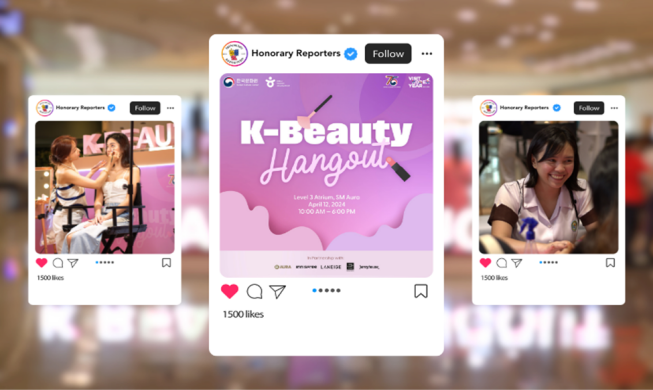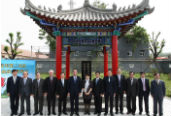-
 Korea.net's 24-hour YouTube channel
Korea.net's 24-hour YouTube channel- NEWS FOCUS
- ABOUT KOREA
- EVENTS
- RESOURCES
- GOVERNMENT
- ABOUT US
- 한국어
- English
- 日本語
- 中文
- العربية
- Español
- Français
- Deutsch
- Pусский
- Tiếng Việt
- Indonesian
He was Ahn Jung-geun, who was found guilty of shooting former Japanese Prime Minister and then Resident-General of Korea Ito Hirobumi (1841-1909) at Harbin Station, in Heilongjiang, China, five months earlier, on October 26, 1909. At the time, Ahn was 32-years-old.
Although he has passed way, the spirit of Ahn, who sacrificed himself in the struggle for Korean independence, still lives on the hearts of many Koreans today.
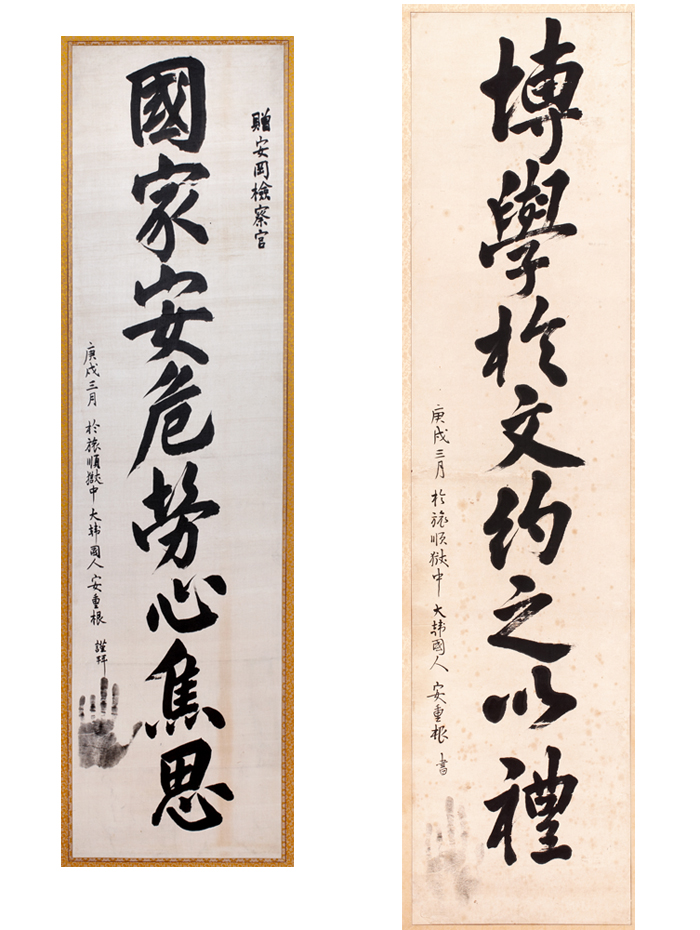
(Left) A short piece of calligraphy made in prison by Ahn Jung-geun reads, "(I) worry and agonize over the security of our country." Ahn wrote it to a military prosecutor who questioned him. (Right) Another piece of his handwriting reads, "(I) study a wide range of subjects and control myself with courtesy."
In celebration of the 70th anniversary of Korea's independence and the 105th anniversary of Ahn's death, the "Eyes on Ahn Junggeun" exhibit is now underway at the National Museum of Korean Contemporary History in downtown Seoul. The exhibit is divided into three parts and consists of displays that look back on Ahn before and after the act of assassination.
The exhibition also narrates his views on the purpose of his deed, which he said was to, "reclaim Korea's sovereignty," and to promote, "peace across Asia."
The exhibit features a photograph of the handgun which he used when he shot Hirobumi, and ten of his calligraphy samples on which he placed a handprint, including the one that reads, "Gyeongcheon," which shows his respect for the sky. There are also many artifacts, photographs and videos in the exhibit.
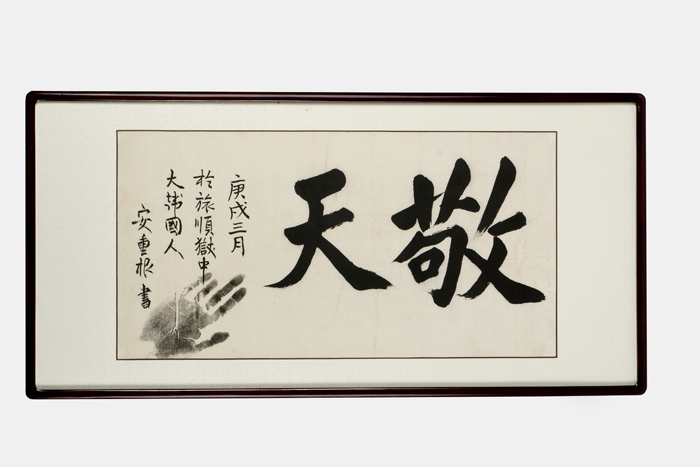
Ahn Jung-geun's calligraphy reads, 'Gyeongcheon,' which means, 'Respect for the Sky.' Ahn wrote this while in the Lushun prison.
An extra edition of the Gyeongseongilbo, a daily newspaper, reports that Ito Hirobumi died one hour after his assassination, and that the assailant was arrested by the police. The extra edition went to press on October 26, 1909, one day after the assassination.
The first section of the exhibit, "A Gunshot That Echoed in Harbin Station," shows a telegram asking about the assassination, a newspaper extra that was issued one day after the assassination and a postcard Ahn sent to Father Nicolas Joseph Mare Wilhelm. The exhibit shows the passage of Ahn's life as he made various efforts to reclaim Korea's sovereignty, including assassination and fighting as a member of a militia group.
The second section of the exhibit, "Outcry That Echoed in Lushun," shows a manuscript of his, "Theory for Peace in the East," which Ahn co-authored with other independence fighters. Ahn wrote the manuscript in prison to outline the true motivation of his deed, and it truly shows his yearning for Korean independence. Ahn gave up on his trial and wrote the text to explain the true reason for committing the act of assassination.
The third section of the exhibit, "A Photograph Kept in the Heart, Great Korean Ahn Jung-geun," consists of biographies and films about Ahn which were released after Ahn's death in 1910. There are many items that outline Ahn's life and his act of assassination, and how Ahn is described in school textbooks through to today, among other items.
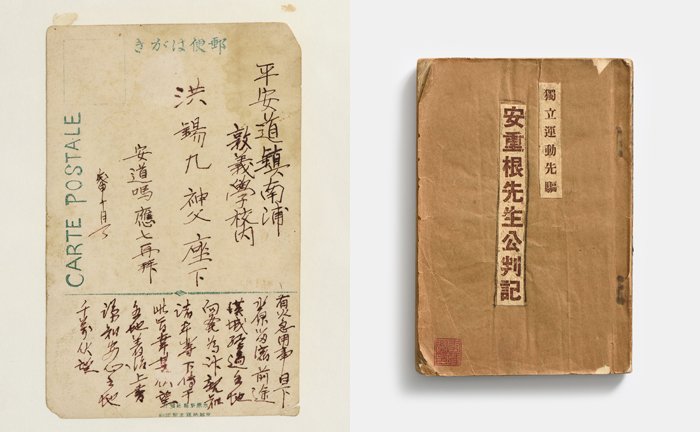
(Left) The museum has one of the postcards Ahn Jung-geun sent to Father Nicolas Joseph Mare Wilhelm. (Right) The exhibit has on display the record of Ahn Jung-geun's trial, the first trial record ever published in Korea.
"We tried to show his strong will to achieve Korean sovereignty and independence by highlighting his life before and after the assassination," said Kim Wang-sik, director of the National Museum of Korean Contemporary History. "The calligraphy samples and photographs that show his yearning for peace across Asia teach us a lesson as we celebrate the 70th anniversary of Korean independence."
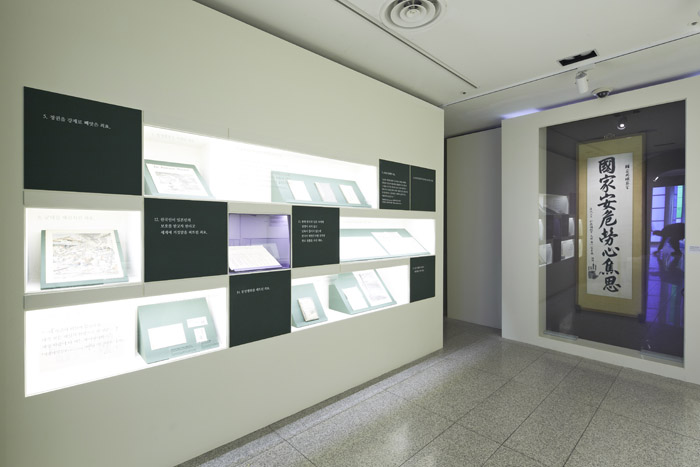
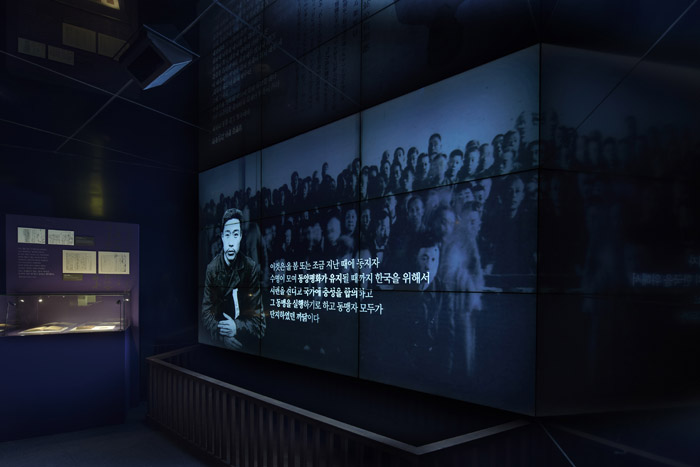
A special exhibition on Ahn Jung-geun is held at the National Museum of Korean Contemporary History.
The exhibition continues till June 7. For more information about the exhibit, please visit the museum homepage(http://www.much.go.kr/en/mainen.do).
By Limb Jae-un
Korea.net Staff Writer
jun2@korea.kr




